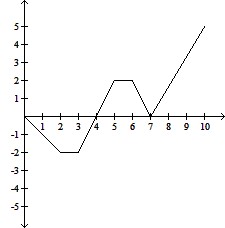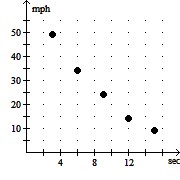Add.14479
A. 908
B. 1619
C. 1038
D. 808
Answer: A
You might also like to view...
The figure shows the velocity v or position s of a body moving along a coordinate line as a function of time t . Use the figure to answer the question. v (ft/sec)
 What is the body's speed when t = 10 sec?
What is the body's speed when t = 10 sec?
A. 3 ft/sec B. 0 ft/sec C. -5 ft/sec D. 5 ft/sec
Find the axis of symmetry of the graph of the parabola.f(x) = -(x + 1)2 - 5
A. x = 2 B. x = 0 C. x = -1 D. x = -5
Solve the problem.A guy wire to a tower makes a 67° angle with level ground. At a point 33 ft farther from the tower than the wire but on the same side of the base as the wire, the angle of elevation to the top of the pole is 38°. Find the wire length (to the nearest foot).
A. 47 ft B. 89 ft C. 84 ft D. 42 ft
Solve the problem.Suppose that the speed of a car, measured in miles per hour (mph), is monitored for some short period of time after the driver applies the brakes. The following table and graph relate the speed of the car to the amount of time, measured in seconds (sec), elapsed from the moment that the brakes are applied.
 What general trend do the data reflect? In which of the time intervals does the speed change the most?
What general trend do the data reflect? In which of the time intervals does the speed change the most?
A. With increasing elapsed time, the speed decreases. The speed changes most during the time interval from 3 seconds to 6 seconds. B. With increasing elapsed time, the speed increases. The speed changes most during the time interval from 3 seconds to 6 seconds. C. With increasing elapsed time, the speed increases. The speed changes most during the time interval from 12 seconds to 15 seconds. D. With increasing elapsed time, the speed decreases. The speed changes most during the time interval from 12 seconds to 15 seconds.